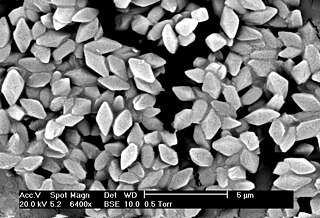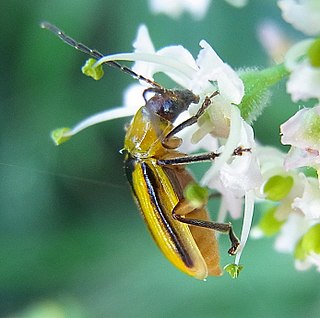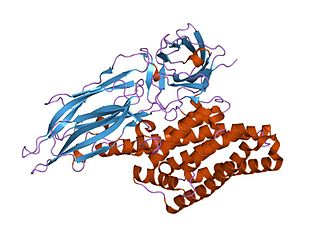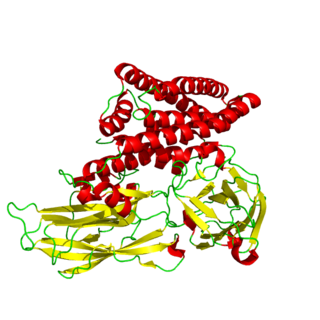Related Research Articles

Bacillus thuringiensis is a Gram-positive, soil-dwelling bacterium, commonly used as a biological pesticide. B. thuringiensis also occurs naturally in the gut of caterpillars of various types of moths and butterflies, as well on leaf surfaces, aquatic environments, animal feces, insect-rich environments, and flour mills and grain-storage facilities. It has also been observed to parasitize other moths such as Cadra calidella—in laboratory experiments working with C. calidella, many of the moths were diseased due to this parasite.

Genetically modified maize (corn) is a genetically modified crop. Specific maize strains have been genetically engineered to express agriculturally-desirable traits, including resistance to pests and to herbicides. Maize strains with both traits are now in use in multiple countries. GM maize has also caused controversy with respect to possible health effects, impact on other insects and impact on other plants via gene flow. One strain, called Starlink, was approved only for animal feed in the US but was found in food, leading to a series of recalls starting in 2000.
Agricultural biotechnology, also known as agritech, is an area of agricultural science involving the use of scientific tools and techniques, including genetic engineering, molecular markers, molecular diagnostics, vaccines, and tissue culture, to modify living organisms: plants, animals, and microorganisms. Crop biotechnology is one aspect of agricultural biotechnology which has been greatly developed upon in recent times. Desired trait are exported from a particular species of Crop to an entirely different species. These transgene crops possess desirable characteristics in terms of flavor, color of flowers, growth rate, size of harvested products and resistance to diseases and pests.

Pesticide resistance describes the decreased susceptibility of a pest population to a pesticide that was previously effective at controlling the pest. Pest species evolve pesticide resistance via natural selection: the most resistant specimens survive and pass on their acquired heritable changes traits to their offspring.

The Western corn rootworm, Diabrotica virgifera virgifera, is one of the most devastating corn rootworm species in North America, especially in the midwestern corn-growing areas such as Iowa. A related species, the Northern corn rootworm, D. barberi, co-inhabits in much of the range and is fairly similar in biology.

Genetically modified crops are plants used in agriculture, the DNA of which has been modified using genetic engineering methods. Plant genomes can be engineered by physical methods or by use of Agrobacterium for the delivery of sequences hosted in T-DNA binary vectors. In most cases, the aim is to introduce a new trait to the plant which does not occur naturally in the species. Examples in food crops include resistance to certain pests, diseases, environmental conditions, reduction of spoilage, resistance to chemical treatments, or improving the nutrient profile of the crop. Examples in non-food crops include production of pharmaceutical agents, biofuels, and other industrially useful goods, as well as for bioremediation.
Bt cotton is a genetically modified organism (GMO) or genetically modified pest resistant plant cotton variety, which produces an insecticide to combat bollworm.

Genetically modified food controversies are disputes over the use of foods and other goods derived from genetically modified crops instead of conventional crops, and other uses of genetic engineering in food production. The disputes involve consumers, farmers, biotechnology companies, governmental regulators, non-governmental organizations, and scientists. The key areas of controversy related to genetically modified food are whether such food should be labeled, the role of government regulators, the objectivity of scientific research and publication, the effect of genetically modified crops on health and the environment, the effect on pesticide resistance, the impact of such crops for farmers, and the role of the crops in feeding the world population. In addition, products derived from GMO organisms play a role in the production of ethanol fuels and pharmaceuticals.

Delta endotoxins (δ-endotoxins) are pore-forming toxins produced by Bacillus thuringiensis species of bacteria. They are useful for their insecticidal action and are the primary toxin produced by Bt corn. During spore formation the bacteria produce crystals of such proteins that are also known as parasporal bodies, next to the endospores; as a result some members are known as a parasporin. The Cyt (cytolytic) toxin group is a group of delta-endotoxins different from the Cry group.
The MON 810 corn is a genetically modified maize used around the world. It is a Zea mays line known as YieldGard from the company Monsanto. This plant is a genetically modified organism (GMO) designed to combat crop loss due to insects. There is an inserted gene in the DNA of MON 810 which allows the plant to make a protein that harms insects that try to eat it. The inserted gene is from the Bacillus thuringiensis which produces the Bt protein that is poisonous to insects in the order Lepidoptera, including the European Corn Borer.

SmartStax is a brand of genetically modified seed made through a collaboration between Monsanto Company and Dow Chemical Company. It takes advantage of multiple modes of insect protection and herbicide tolerance. SmartStax takes advantage of Yieldgard VT Triple (Monsanto), Herculex Xtra (Dow), RoundUp Ready 2 (Monsanto), and Liberty Link (Dow). The traits included protect against above-ground insects, below-ground insects, and provide broad herbicide tolerance. It is currently available for corn, but cotton, soybean, and specialty crop variations are to be released. Previously, the most genes artificially added to a single plant was three, but Smartstax includes eight. Smartstax also incorporates Monsanto's Acceleron Seed Treatment System which protects against insects at the earliest stages of development. Smartstax is sold under the Genuity (Monsanto) and Mycogen (Dow) brands.
The genetically modified brinjal is a suite of transgenic brinjals created by inserting a crystal protein gene (Cry1Ac) from the soil bacterium Bacillus thuringiensis into the genome of various brinjal cultivars. The insertion of the gene, along with other genetic elements such as promoters, terminators and an antibiotic resistance marker gene into the brinjal plant is accomplished using Agrobacterium-mediated genetic transformation. The Bt brinjal has been developed to give resistance against lepidopteron insects, in particular the Brinjal Fruit and Shoot Borer (FSB). Mahyco, an Indian seed company based in Jalna, Maharashtra, has developed the Bt brinjal.

Genetic engineering in the European Union has varying degrees of regulation.
The Séralini affair was the controversy surrounding the publication, retraction, and republication of a journal article by French molecular biologist Gilles-Éric Séralini. First published by Food and Chemical Toxicology in September 2012, the article presented a two-year feeding study in rats, and reported an increase in tumors among rats fed genetically modified corn and the herbicide RoundUp. Scientists and regulatory agencies subsequently concluded that the study's design was flawed and its findings unsubstantiated. A chief criticism was that each part of the study had too few rats to obtain statistically useful data, particularly because the strain of rat used, Sprague Dawley, develops tumors at a high rate over its lifetime.

Gilles-Éric Séralini is a French molecular biologist, political advisor and activist on genetically modified organisms and foods. He is of Algerian-French origin. Séralini has been a professor of molecular biology at the University of Caen since 1991, and is president and chairman of the board of CRIIGEN.

Cry1Ac protoxin is a crystal protein produced by the gram-positive bacterium, Bacillus thuringiensis (Bt) during sporulation. Cry1Ac is one of the delta endotoxins produced by this bacterium which act as insecticides. Because of this, the genes for these have been introduced into commercially important crops by genetic engineering in order to confer pest resistance on those plants.
Bacillus thuringiensis serotype kurstaki (Btk) is a group of bacteria used as biological control agents against lepidopterans. Btk, along with other B. thuringiensis products, is one of the most widely used biological pesticides due to its high specificity; it is effective against lepidopterans, and it has little to no effect on nontarget species. During sporulation, Btk produces a crystal protein that is lethal to lepidopteran larvae. Once ingested by the insect, the dissolution of the crystal allows the protoxin to be released. The toxin is then activated by the insect gut juice, and it begins to break down the gut.

Cry6Aa is a toxic crystal protein generated by the bacterial family Bacillus thuringiensis during sporulation. This protein is a member of the alpha pore forming toxins family, which gives it insecticidal qualities advantageous in agricultural pest control. Each Cry protein has some level of target specificity; Cry6Aa has specific toxic action against coleopteran insects and nematodes. The corresponding B. thuringiensis gene, cry6aa, is located on bacterial plasmids. Along with several other Cry protein genes, cry6aa can be genetically recombined in Bt corn and Bt cotton so the plants produce specific toxins. Insects are developing resistance to the most commonly inserted proteins like Cry1Ac. Since Cry6Aa proteins function differently than other Cry proteins, they are combined with other proteins to decrease the development of pest resistance. Recent studies suggest this protein functions better in combination with other virulence factors such as other Cry proteins and metalloproteinases.
Cry34Ab1 is one member of a binary Bacillus thuringiensis (Bt) crystal protein set isolated from Bt strain PS149B1. The protein exists as a 14 kDa aegerolysin that, in presence of Cry35Ab1, exhibits insecticidal activity towards Western Corn Rootworm. The protein has been transformed into maize plants under the commercialized events 4114 (DP-ØØ4114-3) by Pioneer Hi-Bred and 59122 (DAS-59122-7) by Dow AgroSciences. These events have, in turn, been bred into multiple trait stacks in additional products.
References
- 1 2 "The MON863 case - a chronicle of systematic deception" (PDF). Greenpeace . Retrieved 2010-07-22.
MON863 is a genetically modified corn that expresses a Bt-toxin. This toxin is a modified version of the delta endotoxin Cry3Bb1 which originates from the microorganism Bacillus thuringiensis. The genetic manipulation is aimed at protecting maize plants against a pest called corn rootworm (Diabrotica spp.). MON863 differs from other Bt-corns already placed on the market (MON810, BT11, Bt176), which produce a modified Cry1Ab toxin conferring resistance to a pest called European corn borer (Ostrinia nubilalis), in that it produces an artificial Cry3Bb1 toxin. In addition to the modified Cry3Bb1 toxin gene MON863 contains an antibiotic resistance marker gene.
- 1 2 Doull, J.; Gaylor, D.; Greim, H.A.; Lovell, D.P.; Lynch, B.; Munro, I.C. (2007). "Report of an Expert Panel on the reanalysis by of a 90-day study conducted by Monsanto in support of the safety of a genetically modified corn variety (MON 863)". Food and Chemical Toxicology . 45 (11): 2073–85. doi:10.1016/j.fct.2007.08.033. PMID 17900781.
- ↑ Coghlan, Andy (2010-01-22). "Engineered maize toxicity claims roundly rebuffed". New Scientist. Retrieved 2010-07-21.
- ↑ Lorch, Antje (2005-09-30). "EFSA's Opinion on MON863 hybrids" (PDF). ifrik. Greenpeace. Archived from the original (PDF) on 2011-07-26. Retrieved 2010-07-22.
MON863 contains an GM antibiotic resistance gene (nptII) against kanamycin and neomycin.
- ↑ Staff (8 August 2005) concerning the placing on the market, in accordance with Directive 2001/18/EC of the European Parliament and of the Council, of a maize product (Zea mays L., line MON 863) genetically modified for resistance to corn rootworm Archived 2010-12-31 at the Wayback Machine Commission of the European Communities, Official Journal, Retrieved 17 November 2012
- ↑ Staff (13 January 2006) concerning the placing on the market, in accordance with Directive 2001/18/EC of the European Parliament and of the Council, of a maize product (Zea mays L., line MON 863) genetically modified for resistance to corn rootworm and in 2006 in food Archived 2012-09-05 at the Wayback Machine Commission of the European Communities, Official Journal, Retrieved 17 November 2012
- ↑ "Seralini bio on CRIIGEN". Archived from the original on 2014-03-30. Retrieved 2012-09-22.
- ↑ Reilly, Michael (2010-01-23). "Is Genetically Modified Corn Toxic?". Discovery News. Retrieved 2010-07-21.
- ↑ Staff, ISAAA. Last updated July 27, 2015 Event Name: MON863 See Authorizations tab. Accessed June 2, 2016
